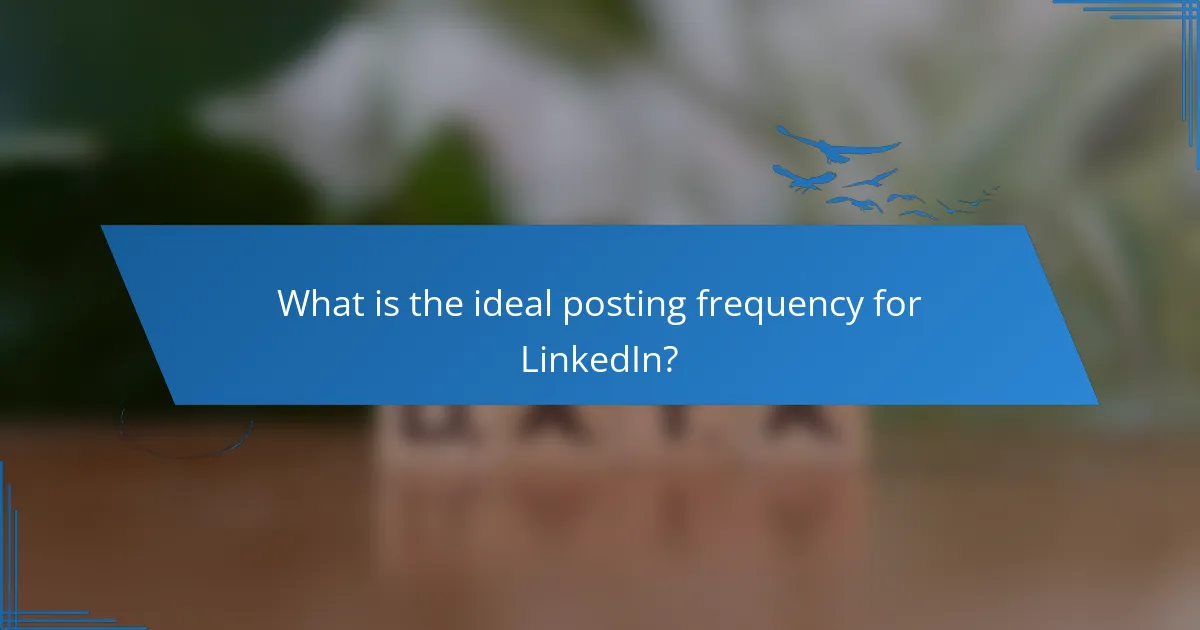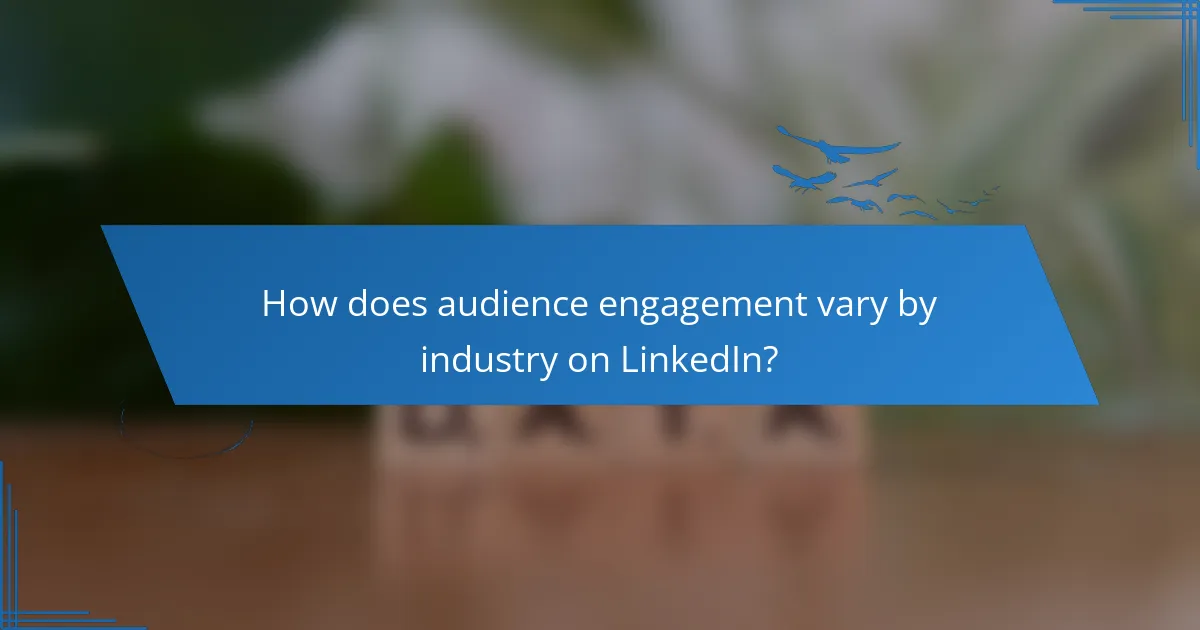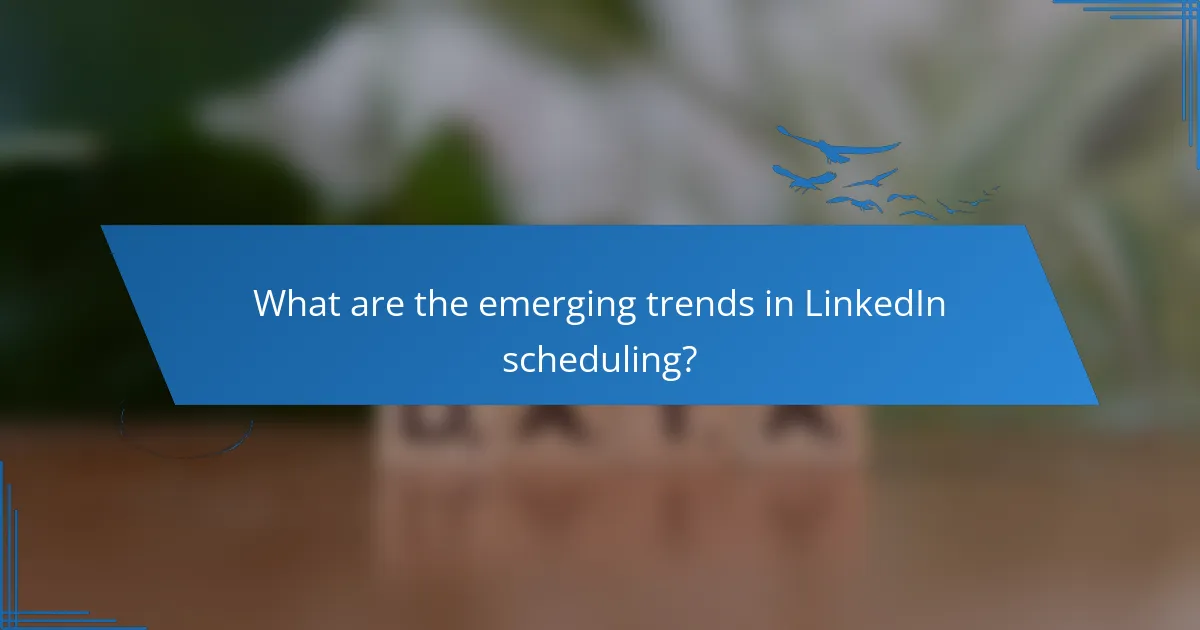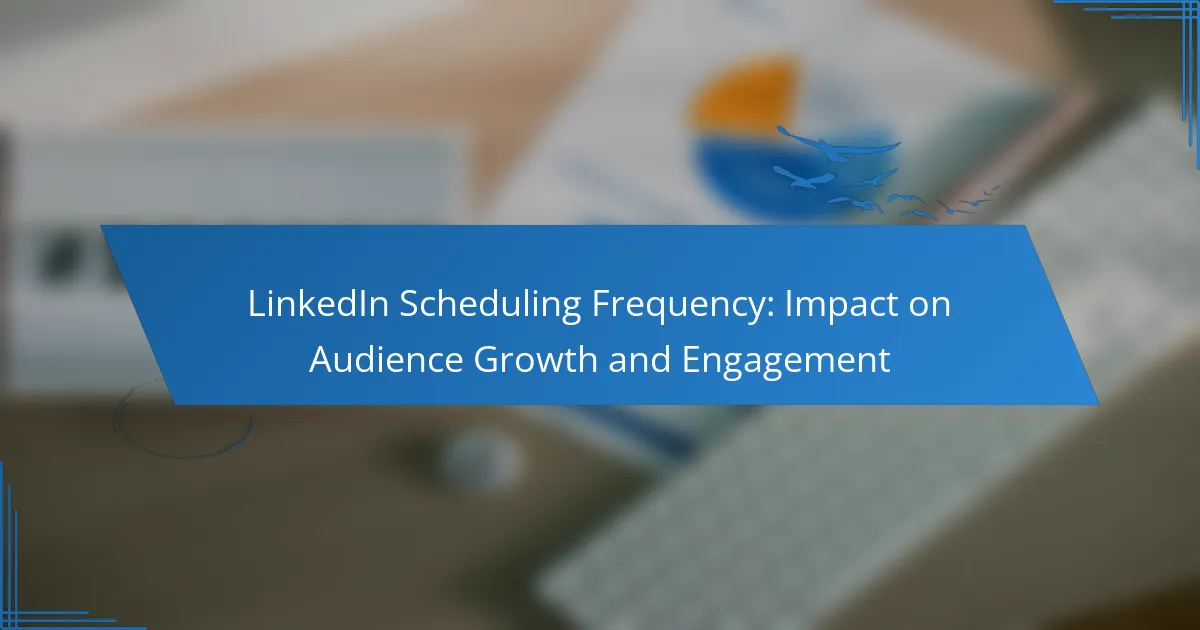Scheduling frequency plays a crucial role in audience growth and engagement on LinkedIn. By posting regularly, ideally three to five times per week, you can enhance your profile’s visibility and foster meaningful interactions with your audience. Utilizing scheduling tools further optimizes your posting strategy, ensuring that your content reaches followers at the best times for maximum impact.

How does scheduling frequency affect audience growth on LinkedIn?
Scheduling frequency significantly impacts audience growth on LinkedIn by enhancing visibility and engagement. Regularly posting content keeps your profile active, attracting more followers and fostering interactions with your audience.
Increased visibility through regular posts
Consistent posting increases your visibility on LinkedIn, making it more likely that your content will appear in users’ feeds. When you share valuable insights or updates regularly, you establish yourself as a reliable source of information, encouraging users to follow you.
Consider posting at least two to three times a week to maintain a steady presence. This frequency helps to keep your audience engaged and informed, ultimately leading to greater audience growth.
Optimal posting times for UK audiences
For UK audiences, the best times to post on LinkedIn are typically during weekdays, especially Tuesday through Thursday, between 8 AM and 10 AM and again from 4 PM to 6 PM. These time slots align with when professionals are most active on the platform, increasing the likelihood of engagement.
Experimenting with different times within this range can help you identify when your specific audience is most responsive. Use LinkedIn analytics to track engagement metrics and adjust your posting schedule accordingly.
Engagement spikes with consistent scheduling
Consistent scheduling can lead to spikes in engagement as followers begin to anticipate your posts. When users know when to expect new content, they are more likely to interact with your posts, which can enhance your visibility further.
Avoid long gaps between posts, as this can lead to decreased engagement. Aim for a regular posting rhythm, and consider using scheduling tools to plan your content in advance, ensuring you maintain consistency even during busy periods.

What is the ideal posting frequency for LinkedIn?
The ideal posting frequency for LinkedIn typically ranges from three to five times per week. This frequency helps maintain visibility and engagement without overwhelming your audience.
Recommended frequency for maximum engagement
To achieve maximum engagement on LinkedIn, aim for about three to five posts each week. This allows you to consistently share valuable content while giving your audience time to absorb and respond to your posts. Posting too frequently can lead to diminishing returns, as followers may feel bombarded.
Consider varying your content types, such as articles, updates, and multimedia, to keep your audience engaged. Monitoring engagement metrics can help you adjust your frequency based on what resonates most with your followers.
Impact of posting daily versus weekly
Posting daily can increase visibility but may also lead to audience fatigue if the content is not engaging. While daily posts can keep your profile active, they should be high-quality and relevant to maintain interest. In contrast, posting weekly allows for more thoughtful content creation and can foster deeper engagement.
Evaluate your audience’s response to different posting frequencies. If you notice a drop in engagement when posting daily, consider scaling back to a few times a week to find a balance that works for your network.

How can LinkedIn scheduling tools enhance engagement?
LinkedIn scheduling tools can significantly enhance engagement by allowing users to post content at optimal times, ensuring maximum visibility and interaction. By automating the posting process, these tools help maintain a consistent presence, which is crucial for audience growth and retention.
Benefits of using Hootsuite for scheduling
Hootsuite offers several advantages for scheduling LinkedIn posts, including a user-friendly interface and robust analytics. Users can plan their content calendar in advance, ensuring a steady flow of posts that align with audience activity patterns.
Additionally, Hootsuite provides insights into the best times to post based on audience engagement metrics. This allows users to adjust their scheduling strategy effectively, potentially increasing interaction rates by targeting peak activity times.
How Buffer optimizes post timing
Buffer specializes in optimizing post timing by analyzing when followers are most active. This tool suggests ideal posting times tailored to individual audience behaviors, which can enhance engagement significantly.
By utilizing Buffer’s scheduling capabilities, users can automate their posts to go live during these peak periods. This strategic timing can lead to higher visibility and interaction, making it easier to grow an audience on LinkedIn.

What metrics should be monitored for audience engagement?
To effectively gauge audience engagement on LinkedIn, focus on metrics such as likes, comments, shares, and click-through rates. These indicators provide insights into how well your content resonates with your audience and can guide your content strategy.
Key performance indicators for LinkedIn posts
Key performance indicators (KPIs) for LinkedIn posts include engagement rate, which is calculated by dividing total interactions (likes, comments, shares) by impressions. A good engagement rate typically falls between 1% and 5%, depending on your industry and audience size.
Another important KPI is the follower growth rate, which indicates how quickly your audience is expanding. Monitoring this metric helps assess the effectiveness of your content in attracting new followers. Aim for a steady increase, ideally in the low double digits percentage-wise each month.
Tools for tracking engagement metrics
Several tools can help track engagement metrics on LinkedIn. LinkedIn Analytics provides built-in insights into post performance, audience demographics, and engagement trends. This tool is essential for understanding which types of content perform best.
Additionally, third-party tools like Hootsuite or Sprout Social offer more comprehensive analytics, allowing you to compare performance across multiple social platforms. These tools often include features for scheduling posts, which can enhance your overall strategy by optimizing posting times based on audience activity.

How does audience engagement vary by industry on LinkedIn?
Audience engagement on LinkedIn significantly differs by industry, influenced by factors such as content type, posting frequency, and audience expectations. Understanding these variations can help tailor strategies for better interaction and growth.
Engagement trends in technology sectors
In the technology sector, engagement tends to be higher due to the audience’s interest in innovation and industry trends. Companies often share insights, case studies, and thought leadership articles that resonate well with tech professionals.
Posting frequency can vary, but a consistent schedule of 3-5 times per week is generally effective. Engaging with followers through comments and discussions can further enhance visibility and interaction.
Differences in engagement for finance professionals
Finance professionals typically engage with content that is data-driven and analytical. Topics like market trends, investment strategies, and regulatory changes are particularly appealing, leading to higher engagement rates.
For finance-related posts, a frequency of 2-4 times per week is often sufficient to maintain interest without overwhelming the audience. It’s crucial to ensure that the content is relevant and timely to foster meaningful discussions and connections.

What are the prerequisites for effective LinkedIn scheduling?
Effective LinkedIn scheduling requires a clear understanding of your audience and well-defined content goals. These prerequisites ensure that your posts resonate with your target demographic and achieve desired engagement levels.
Understanding audience demographics
Knowing your audience demographics is crucial for tailoring your content and scheduling strategy. Factors such as age, location, industry, and job roles can significantly influence when and how often you should post.
For instance, if your audience primarily consists of professionals in the tech industry, consider scheduling posts during typical work hours, such as mid-morning or early afternoon on weekdays. Use LinkedIn analytics to gather insights about your audience’s active times and preferences.
Setting clear content goals
Establishing clear content goals helps guide your LinkedIn scheduling efforts. Determine whether your aim is to increase brand awareness, drive traffic to your website, or generate leads, as each goal may require a different posting frequency and content type.
For example, if your goal is to boost engagement, consider posting more frequently—perhaps several times a week—while ensuring the content remains relevant and valuable. Avoid overwhelming your audience with excessive posts, as this can lead to disengagement.

What are the emerging trends in LinkedIn scheduling?
Emerging trends in LinkedIn scheduling focus on leveraging technology and personalization to enhance audience engagement and growth. As businesses adapt to these trends, they can better connect with their target audiences and optimize their content delivery strategies.
AI-driven scheduling tools
AI-driven scheduling tools are becoming essential for optimizing LinkedIn content posting. These tools analyze audience behavior and engagement patterns to determine the best times to post, maximizing visibility and interaction. By automating scheduling, businesses can ensure consistent content delivery without manual intervention.
Examples of popular AI-driven tools include Buffer and Hootsuite, which offer features like predictive analytics and optimal timing suggestions. Utilizing these tools can lead to increased engagement rates, as posts are shared when audiences are most active.
Personalization in content delivery
Personalization in content delivery is crucial for capturing audience interest on LinkedIn. Tailoring content to specific audience segments can significantly enhance engagement, as users are more likely to interact with material that resonates with their interests and needs. This approach can involve adjusting messaging, visuals, and even posting times based on audience preferences.
To implement personalization effectively, businesses should analyze their audience demographics and engagement metrics. A/B testing different content formats and styles can also provide insights into what resonates best. Avoid generic posts; instead, focus on creating targeted content that speaks directly to your audience’s unique challenges and aspirations.
